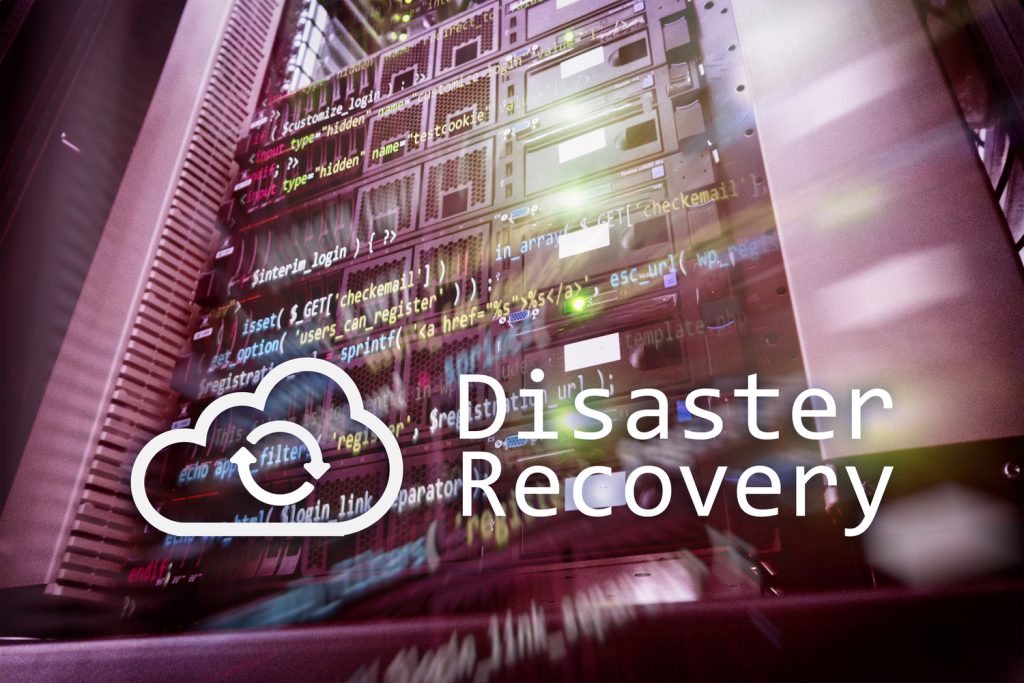- July 28, 2022
- Catagory business continuity
Why any data-driven business needs a UPS
We often talk about how data is the lifeblood of every business, but it’s not much use without power. That’s why any disaster recovery plan should include the use of an uninterruptable power supply (UPS).
Regardless of why there there’s a power loss, be it natural disaster, a localized outage, or a wider electricity grid failure, you need to keep mission critical systems up and running as best you can.

Having a UPS in place assumes your primary facility is still operational – depending on the natural disaster, your primary location could be physically damaged by fire or flood, for example. But if it is undamaged aside from a power outage, having a UPS kick in immediately for mission critical systems enables business continuity with little disruption to your customers.
Bear in mind that a UPS is not a standby generator or an auxiliary power system – it’s a battery-based device that will deliver provide near-instantaneous power as soon as an outage of the primary power source is detected. No matter how extreme the disruption, a UPS will provide a constant, consistent stream of energy. It will also compensate for other power-related issues such as voltage surges, spikes and sags, and any frequency differences – having a UPS in place all about maintaining stability during a disruption.
That being said, it may not be feasible to keep all systems running with a UPS, so your disaster recovery plan should outline which systems need to be maintained in the event of a power outage. If you’re a healthcare provider, for example, you’ll want to focus on powering the systems essential for delivering critical care in a hospital – having reliable power becomes a matter of life or death.
A healthcare facility is much like a data center, and even if you’re leveraging cloud computing for applications and data storage, any business regardless of its focus still has some on-premises IT infrastructure that needs to keep running, including network gear to connect to those cloud services. Ideally, any primary power outage is temporary and will enable you to continue core operations until the issue is resolved. Worst case scenario, you’ve bought time to figure out what your longer-term strategy will be if the nature of the interruption is especially serious and not expected to be resolved quickly, which can be the case with weather-related disasters.
If you’ve not included a UPS in your data protection and disaster recovery planning and you’re not sure how to best configure one, consult your managed service provider. Given their uptime commitments, they understand the need for uninterruptable power supply if they are to meet their Service Level Agreements (SLAs) with their customers.
Your managed service provider can help you map out where best to deploy a UPS and prioritize what systems must stay on at all costs – reliability and redundancy are their reasons for being. They can also help you refresh and update your disaster recovery plan to ensure business continuity in the event of a power outage.
As much as data is the lifeblood of business, there’s no pulse without power. And remember, it’s just a matter of when a major disruption occurs, not if, whether it’s bad weather that causes a power outage or a problem with the local grid. Having a UPS is essential if you’re to restore data and applications without any noticeable interruptions to key business functions.
- June 30, 2022
- Catagory cloud backup
4 Key Elements of Cloud-Based Disaster Recovery
Implementing cloud-based disaster recovery is the best way to minimize disruption and maximize business uptime, but you won’t realize the benefits without keeping four key elements in mind.
Data classification
Not all data needs to be backed up – it’s simply not cost effective, even with cloud solutions. You should understand what data you’re backing up, why and how quickly you need to restore it to keep your business running and avoid disruption for your customers.

Remember that not all business information is created equal. While some data must be archived and replicated offsite to meet compliance and regulatory commitments, mission critical information and applications should always take priority, with clear recovery time objectives (RTO) and recovery point objectives (RPO) so you restore operations quickly in event of any type of disruption.
Platform and provider selection
You want to simplify your cloud-based disaster recovery implementation as much as possible by using as few data protection tools as possible while covering all essential applications and systems – this where a managed service provider can provide guidance by applying their experience and recommending the best cloud-based disaster recovery solution for your needs.
Keep in mind you’re not just evaluating the technologies that back up and restore your data. You must also evaluate the provider’s infrastructure and track record. Your business goals, RPOs and RTOs, and any other requirements should be reflected any Service Level Agreement (SLA) and their data management policies.
Comprehensive testing
Never assume your cloud-based disaster recovery is working – you should know for sure through testing before implementing and then conducting regular fire drills once it’s up and running. Remember that the value of any solution comes down to how quickly and easily you can restore data and applications while minimizing disruption to your business operations and customers. They can be established through a proof of concept that runs through some likely scenarios to verify that your cloud-based disaster recovery is meeting the business goals, as well as your RPOs and RTOs.
Ongoing adjustments
Your disaster recovery plan is a living document. Together with your managed service provider, it should be adjusted and tweaked regularly to reflect changes in the business, including application upgrades, while also applying product patches and updates to the cloud back up solutions themselves. Be sure you and your managed service provider are on the same page as to who is responsible for what.
Maintaining cloud-based disaster recovery as an ongoing activity, not a one-time IT project, and you should always be reassessing its performance. Regular reports from your managed service provider allows you to understand if you are meeting the objectives and having confidence that disruption will be minimal when disaster strikes.
- May 26, 2022
- Catagory Data Protection
Every data backup plan must be put through its paces
A robust cybersecurity strategy is not the only way organizations protect sensitive information – having a data backup plan that’s tested regularly is essential to ensure complete protection.
While putting a disaster recovery plan in place can be daunting for small or medium-sized organization, it must be done because it’s only a matter of time before you face a major disruption that threatens your mission-critical business data. However, thanks to the cloud, its easier than ever to implement enterprise-class data backup with the help of an experienced managed service provider.

Your data backup plan should be part of a broader and comprehensive disaster recovery plan, which identifies all the activities, resources and procedures needed to carry out all processing requirements during interruptions to normal business operations. You may be tempted to back up all your data and applications, but ideally, you should focus on identifying the data and applications that are essential for running the business.
Even more important is to make sure your data backup is running properly. It’s easy to get complacent and take for granted that your backups are running on schedule and safeguarding the right data. But whether you maintain your own backup infrastructure or adopt a managed backup service from a outside provider, you must regularly test your backups.
It’s easy to get out of the habit of testing your data backup and assume you’re backing up essential data and applications when there are more pressing demands on your IT staff. However, none of the more strategic technology initiatives you’re pursuing will matter because your business can’t afford the downtime that comes with a disruption related to a data loss – it means lost revenue, productivity, and the loss of current and future customers due to a negative perception of your brand.
Whether it’s your broader disaster recovery plan or just your data backup process, you should be doing regular fire drills. Even if your data backup is still working, it may not be keeping up with changes to your business – your data and applications are not static. Applications and data evolve, and a dynamic environment requires regular monitoring. Whether you do your own backups or outsource it, you should always be testing, and any credible managed service provider will always be testing without you having to ask and part of your Service Level Agreement (SLA).
Knowing the right data is being backed up is not enough either. You should also have peace of mind that you can restore it and any applications quickly to minimize any interruptions in business operations. Your restoration process is a critical aspect of any data backup plan. Your fire drill should demonstrate the ability to mount the backup and access the relevant files quicky and that a virtualized backup copy is bootable. Remember that your storage used for backup is subject to defects, and files can be accidentally erased or overwritten. If your primary storage can fail, so can your secondary.
Even if you do have the capability to maintain a data backup plan in-house, it’s one more thing on the to do list of your IT staff and distracts them from more strategic initiatives, so you should consider engaging a managed service provider that can remotely monitor and manage your backup infrastructure, as well as send your backups to their hosted backup repository. This will reduce your capital expenditures and simplify your data backup.
Remember: It’s just a matter of when, not if, your organization will be faced with major data loss, so no matter how you decide to implement your data backup, regular testing not only minimizes disruptions to operations and your customers, but it also allows you to stay in business.
- May 30, 2019
- Catagory business continuity
3 Key Benefits Of A Business Continuity Plan
You might think a business continuity plan is a luxury—something only larger organizations can afford or something you’ll do during a slow period. But planning for disaster is not just good preventative medicine. It contributes to a healthy business in three meaningful ways.

Culture
Being prepared is a state of mind. When your team knows you’re prepared for the worst, they can move forward with any business initiative with confidence.
Organizations that have a business continuity plan in place nurture employees that are adaptable and proactive when things to do go wrong. Planning for disaster becomes a subtle part of everything they do, making them adept at automatically assessing the levels of risk associated with new ventures and more agile. Small disruptions don’t phase them because the business already has a plan in place for the worst-case scenario.
Competitiveness
The confidence your employees have because you’ve got a rock-solid business continuity plan is picked up by your customers. Letting them know you’re proactively planning for disaster sends a message they can count on you, and so can your investors, business partners and other stakeholders.
Having a business continuity plan can also set you apart from your competitors and is something you can market to potential customers. They may not even consider that your planning is in their best interests, but it will help you stand out when it comes time for them to make a buying decision.
Compliance
In an era of privacy legislation that includes the Personal Information Protection and Electronic Documents Act (PIPEDA) and the General Protection Data Regulation, planning for disaster helps you stay compliant with government regulation and industry standards—yet another way to maintain competitive advantage.
Even if your industry isn’t heavily regulated, adhering to standards and best practices by keeping them in mind during your business continuity planning demonstrates a commitment to quality and accountability. Should new legislation be introduced that affects your operations, or you expand your business into a more regulated sector, having a mindset in place that guarantees business uptime will help you easily adapt to new realities quickly, giving both you and your customers peace of mind.
Business continuity keeps you ahead of the game
Planning for disaster is a must-have, not a nice-to-have. Don’t wait until the worst-case scenario hits before you start your business continuity planning. Making the upfront investment today will pay off in the form of confident employees and customers, and a healthy bottom line.
If you haven’t begun to think about disaster recovery planning or feel your plan needs an update, check out our Disaster Recovery Primer.




 Latest Blogs
Latest Blogs FAQ
FAQ